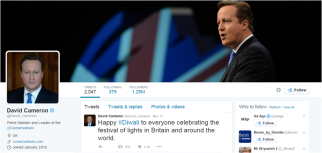On May 8th 2015, David Cameron secured his place in Conservative party hall of fame by leading the first majority Tory government for decades. It was by all accounts, an unprecedented and historic result that left politicians eating their hats, journalists red-faced with wildly inaccurate projections and Labour evicted from Scotland.
Fundamentally though, it all came down to a battle of personalities – David Cameron, the Eton and Oxford educated ‘Toff’ or most Prime Ministerial candidate versus Ed Miliband, the slightly robotic and awkward, everyone-loves-an-underdog candidate (depending on your stance). Not to mention the ‘leader of the purple army’, Nigel Farage – another larger than life personality that moved the dial further along for his party in one year, than the entire decade prior to the election. This battle was no better observed than in the multiple TV debates, where different styles were showcased, and the country not only observed but got involved.
The nature of this involvement was social media. In the first truly digital British election, the major political parties used various platforms from Twitter to Facebook to Instagram, as a strategic weapon to be yielded, with apparently evident success. An analysis of the social media numbers are clear – the conservative party had the largest social audience of the main parties (726k), followed by Labour with 604k1. The power of this social media connection, is that is brings the individual closer to the politician and creates a turbo-charged ‘parasocial interaction’2. A regular interaction of this kind occurs when members of the public feel that they have a relationship with characters in the media. The fact that media figures can communicate to us directly via social media amplifies this interaction and makes it much more intimate and personal. The character is the focal point here. Perhaps even more so than the ideology or values he or she represents. I follow my favourite sports personality on Instagram & Twitter – when he posts a picture or tweets, it comes straight to my phone. In the somewhat strange reality which is the social media world, it sometimes feels like I have an actual relationship with him. Or at least, the connection is a little less distant than it has previously ever been. Against this backdrop, the individuality of a politician is acutely experienced and his or her personality plays a critical role in how successful his or her party becomes – Nicola Sturgeon and SNP ascendance being a great example.
I have been fascinated with the concept of leadership for many years. What is takes to be successful and how individuals can yield so much influence over organisations, countries and global institutions are questions which keep me fairly occupied. In my line of work, we assess and benchmark leaders against a research based, context dependent ‘success’ profile, often for senior level roles within organisations. Two of the dimensions of such a profile include ‘traits’ and ‘competencies’, reinforcing the importance and contribution of personality and key skills in the make up of those in positions of authority. Recent research by Silvester, Wyatt & Randall (2014) found that the typical profile of high potential UK politicians consisted of the following Big 5 traits (percentiles vs. general population):
Extraversion – 54th
Agreeableness – 38th
Conscientiousness – 21st
Neuroticism – 73rd
Openness – 46th
Interestingly, when these traits were correlated with performance ratings on competencies (based on colleague ratings), there was a significant relationship between conscientiousness and resilience and analytic skills, both competencies which were deemed critical for success and a negative relationship between these competencies and Neuroticism. So paradoxically, despite the profile of politicians here showing high Neuroticism and low Conscientiousness, those who were rated as performing successfully, are perhaps adaptable enough to flex their natural tendencies and exhibit behaviours which exude social prowess, assertiveness, a busy-body style, empathy, achievement drive and emotional control. And so, tuning up and tuning down certain behaviours or being interpersonally/ emotionally agile seems to be a very important skill.
However, of course this is the self-perception of politicians and ratings by their peers. What would be even more telling would be to build a success profile of politicians’ personality based on the public’s view of desirable traits. Maybe a strategy that Labour HQ should adopt, given the much discussed un-electability of the current leader of the opposition, Mr Corbyn? As the power of social media continues to drive the potency of the parasocial relationship we have with our politicians, personality and the holistic view of the individual will become an ever increasingly important factor in who wins future elections and with it, the unparalleled responsibility of leading nations.
Thoughts, critiques and questions welcomed as ever.
References
1 – https://www.integritysearch.co.uk/infographics/social-media-statistics-general-election-2015/
2 – Horton, D., & Wohl, R. R. (1956). Mass communication and para-social interaction. Psychiatry, 19, 215–229.
3 – Silvester, J. Wyatt, M. & Randall, R. (2014) Politician personality, Machiavellianism, and political skill as predictors of performance ratings in political roles, Journal of Occupational & Organizational Psychology, Vol. 87 Issue 2, p258‐279.








